Contents
Biography, Contact information, News
Archive, Sunsets, Notes From Underground, Waves, 2012-2015
Texts, Reviews, Published projects
Exhibition documents, 2017





Lisa Tan, My Pictures of You (2017), Installation view
Lisa Tan, My Pictures of You (2017), Installation view
Lisa Tan, My Pictures of You (2017), Installation view
Lisa Tan, My Pictures of You (2017), Installation view
Lisa Tan, My Pictures of You (2017), Installation view
|<<
<
>
>>|
1 - 5
Extracts from a Future History
November 15 – December 3, 2017
Fanny Carinasdotter, Tomas Örn, Anja Örn, Yuri Pattison, Raqs Media Collective
Eva Stina Sandling, Lisa Tan
Lisa Rosendahl, curator
Public Art Agency Sweden
Statens Konstråd
Hälsingegatan 45
113 31 Stockholm
The exhibition is the final segment of Public Art Agency Sweden’s exhibition series Industrial Society
in Transition, which has taken place in different parts of the country since 2015. In Luleå, the thematic starting point is “extraction” and how this value-creating activity has developed from mining activities to data analysis. The materiality of mineral mining and the invisible data streams of the digital age have more in common than one might think. Both data networks and heavy industry are dependent on enormous amounts of energy, and the production of computer hardware involves metals that are extracted via mining. As our own planet is drained of its resources, the industry looks toward other celestial bodies for future mining prospects. The enormous amount of data we leave behind on the internet is reused by commercial businesses, and the most intimate aspects of our lives become commodities. Does technological development create new opportunities for life or will Earth and humankind gradually be reduced to a state of impoverishment?
Curator's text PDF (2.5 MB)
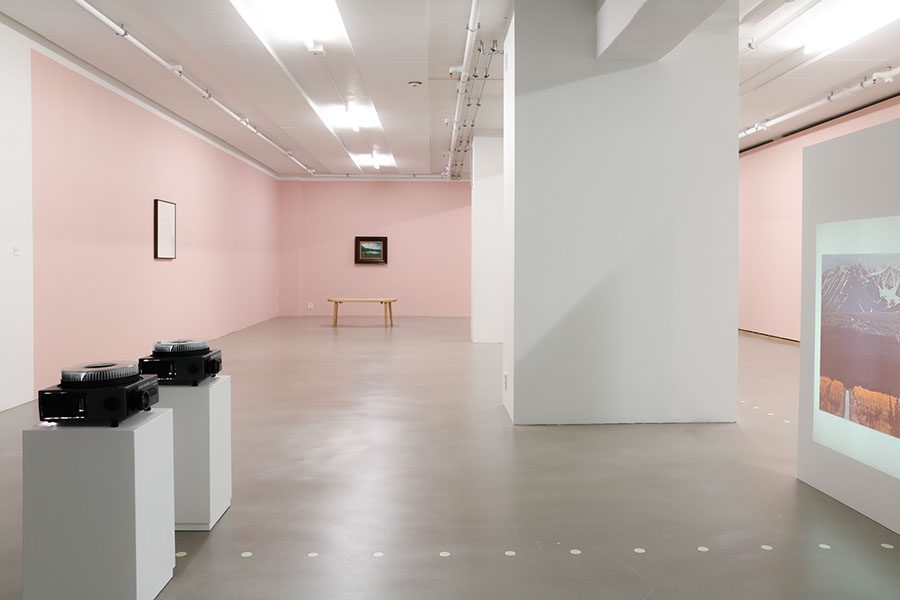


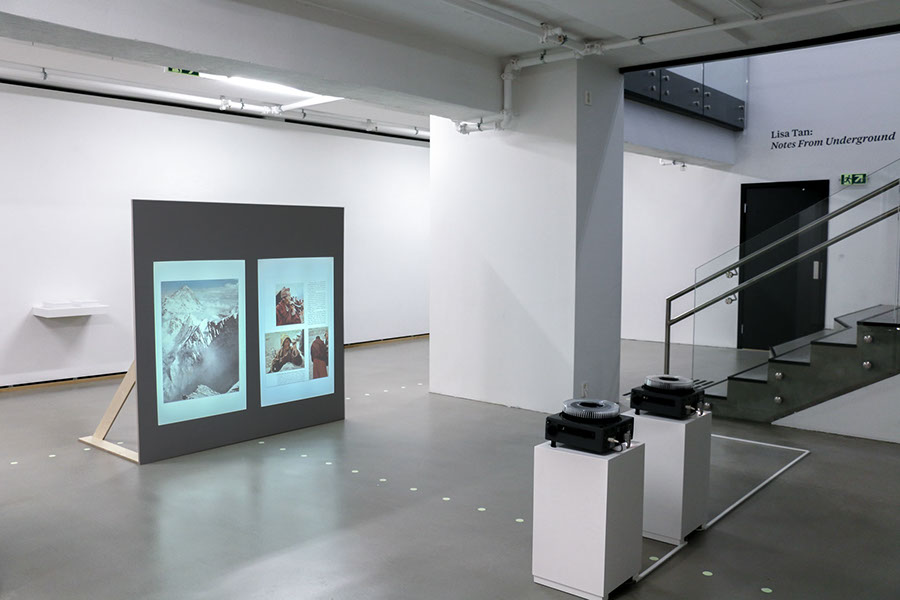


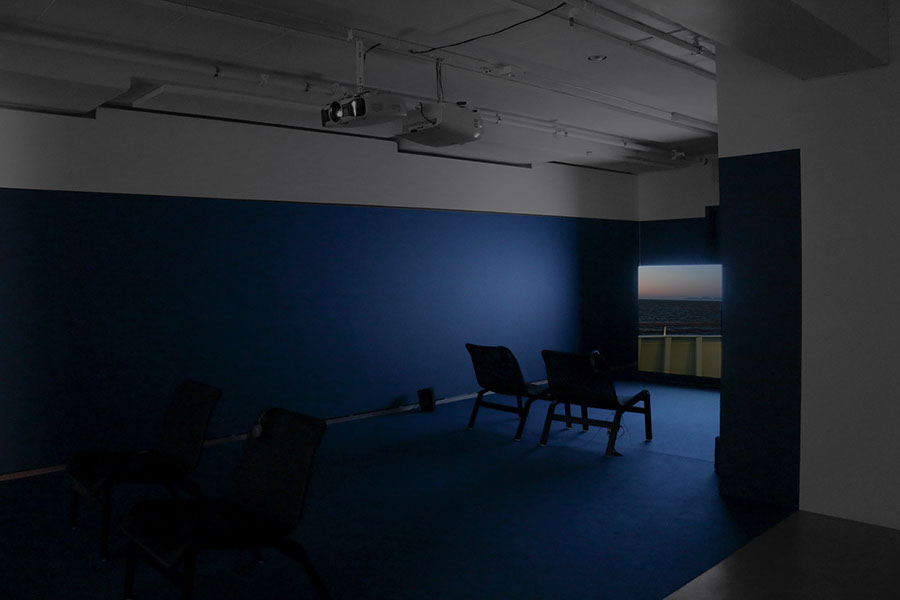



|<<
<
>
>>|
6 - 10
Lisa Tan Notes from Underground
September 28–December 21, 2017
Opening and artist conversation: September 28, 6:30pm
Kunsthall Trondheim
Kongens gate 2
7011 Trondheim
Norway
The Brazilian writer Clarice Lispector wrote at dawn, searching for “whatever is lurking behind thought." Behind thought. Certainly then—also behind words?
Notes from Underground presents works by Lisa Tan (USA/Sweden). The exhibition contains a series of three films and two installation works, Moving a Mountain (2008) and National Geographic (2009), which precedes the films. Together they form a line of thinking and express the artist´s interest in liminality, in-between-ness.
Lisa Tan echoes Virginia Woolf´s intentions for the novel The Waves—to follow a rhythm rather than a plot. Her films Sunsets (2012), Notes From Underground (2013) and Waves (2014) contain, however distinctly edited, a floating element, something unstable and open. Guided by currents and undercurrents, they are constantly eluding you—subjects, histories and memories rise to the surface only to sink away again. Voices appear and are lost.
In Sunsets we hear Lispector´s voice from 1977 together with that of a friend of the artist´s, doing a translation over Skype, both searching for the right words, hesitating, uncertain. The language drifts. Maybe here, through the gap in and between languages, in this state of formlessness, we can briefly perceive what Lispector calls the “it” of the language.
While many subjects are touched upon in the films—violence, displacement, societal issues—the question that stays with you is maybe in the end that of artistic practice. What is this—to write, to make art? What kind of language could art speak? The films are in a way evolving in search of a possible practice. They stretch out over and beyond the globe, only to return to the artist´s working place—the desk, the computer screens, the everyday.
In this quest, Lisa Tan choses to follow Susan Sontag, Clarice Lispector and Virginia Woolf—Sontag’s refusal to reduce art to what could be explained, Lispector´s words about “the it” or “the is of the thing” or “whatever is lurking behind thought." And Woolf´s concern “with something else”—something else than literature, that is.
Thanks to Galleri Riis, Oslo.
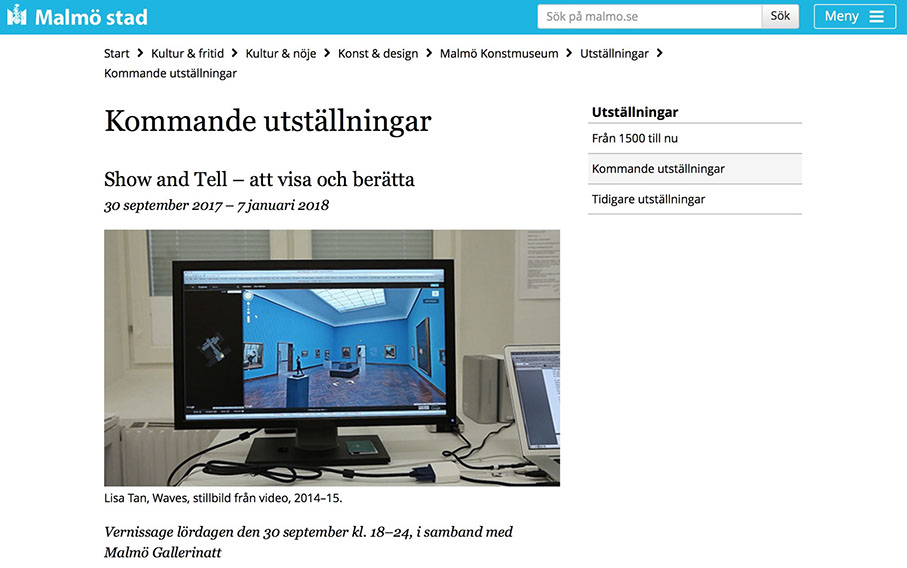
Show and Tell
30 september 2017 – 7 januari 2018
curated by Cecilia Widenheim and Matts Leiderstam
Malmö Konstmuseum
Malmöhusvägen 6
Sweden
Artistic Research and the Museum seminar, November 3, 2018
Vad är ett museum? Denna utställning har tillkommit i ljuset av de senaste årens diskussioner om ett nytt konstmuseum i Malmö. Syftet är att lyfta fram samlingen och presentera ett antal konstnärskap och konstverk som känns extra angelägna i vår tid. Samlingen omfattar idag närmare 40 000 verk. Men merparten står sedan länge i magasin och väntar på att möta sin publik.
Ett av museets viktigaste uppdrag är att skapa sammanhang för de verk som på olika sätt hamnat i samlingen, och att ge nya generationer möjligheten att lära känna den. Hur kan besökare och allmänhet ta del av de berättelser som följer med konstverken? Show and Tell föreslår ett antal nya sammanställningar och möten mellan verk som i sin tur skapar nya historier.
I utställningen visas över 300 verk och här finns en rad olika uttryckssätt och tekniker representerade; måleri, teckning, skulptur, installation och video. De äldsta verken är från 1500-talet och några är helt nyproducerade. Urvalet speglar ett samtal om konstmuseets historia och framtid. Vilken roll kan ett konstmuseum ha i den globaliserade bildkultur som vi lever i?

An Inventory of Shimmers: Objects of Intimacy in Contemporary Art
May 19-July 16, 2017
Andrea Büttner, Sophie Calle, Alejandro Cesarco, Jason Dodge, Antonia Hirsch, Félix González-Torres, Jill Magid, Park McArthur, Lisa Tan, Erika Vogt, Susanne Winterling, and Anicka Yi
curated by Henriette Huldisch
MIT List Visual Arts Center
E-15 109 20 Ames Street
Cambridge, MA 02139
Press release:
An Inventory of Shimmers: Objects of Intimacy in Contemporary Art brings together a group of twelve international artists to examine the recent multidisciplinary turn towards affect by focusing on art works that explore how bodies are shaped, modified, or affected by the intensity of their interaction. Many contemporary artists engage with modes of address and content that is tethered to affect, yet at the same eschew sentimentality and expressivity. The exhibition presents works that variously investigate our intimate relationships with objects; works that act as vehicles for affective engagement or transactions of desire, including objects that carry the traces of things we can’t see but have to trust, intuit, or perceive in ways that are not related to vision or hearing; and works that are engaged with actions of interpersonal care, trust, intimacy, or love.
Artists included are Andrea Büttner, Sophie Calle, Alejandro Cesarco, Jason Dodge, Felix Gonzalez-Torres, Antonia Hirsch, Jill Magid, Park McArthur, Lisa Tan, Erika Vogt, Susanne M. Winterling, and Anicka Yi.
An Inventory of Shimmers: Objects of Intimacy in Contemporary Art is curated by Henriette Huldisch, Curator, MIT List Visual Arts Center. The exhibition is accompanied by a 96-page fully illustrated catalogue published by Prestel/DelMonico in association with the MIT List Visual Arts Center. Edited by Henriette Huldisch, the catalogue features essay contributions by Eugenie Brinkema, Associate Professor, Literature Section, MIT; Johanna Burton, Director and Curator of Education and Public Engagement at the New Museum; and Emily Watlington, Curatorial Research Assistant, MIT List Visual Arts Center and graduate student History, Theory and Criticism of Art and Architecture, MIT.
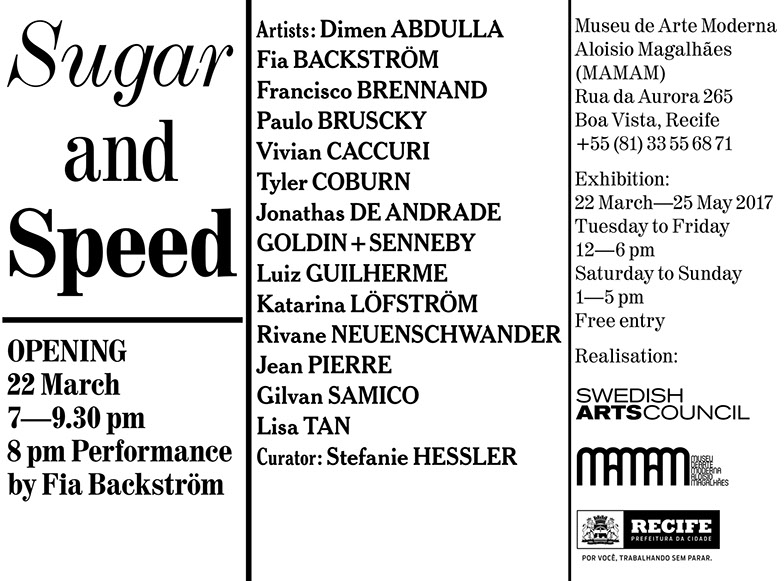
Sugar and Speed
March 22 – May 25, 2017
Dimen Abdulla, Fia Backström, Francisco Brennand, Paulo Bruscky, Vivian Caccuri, Tyler Coburn, Jonathas de Andrade, Goldin + Senneby, Luiz Guilherme, Katarina Löfström Rivane Neuenschwander, Jean Pierre, Gilvan Samico, Lisa Tan
curated by Stefanie Hessler
Museu de Arte Moderna Aloisio Magalhães (MAMAM)
Rua da Aurora 265
Boa Vista, Recife
Brazil
+55 (81) 33 55 6871
excerpt from exhibition text, full version here
THE HISTORY OF Recife, the largest metropolitan area of northeastern Brazil and capital of the state of Pernambuco, cannot be told without the history of sugar and labour. Sugarcane originated from Southeast Asia and Melanesia, and was fist introduced to Brazil in 1532, imported by the Portuguese, who intended to expand their cultivations beyond the Atlantic islands. The colony soon became the principal producer of sugar worldwide with the majority of its plantations and mills situated in Pernambuco thanks to its warm climate and fertile soil. Brazil’s role in the sugar trade weakened in the mid-17th century, after the departure of the Dutch governor Mauricio de Nassau and rivalries between the Portuguese tradesmen of Recife and the sugarcane farmers of the neighbouring Olinda that resulted in the Guerra dos Mascates during the early 18th century. The ensuing Caribbean sugar boom, propelled by the expelled Dutch, led to declining rates of exports from Brazil. While the country never ceased to produce sugar, it regained its leading market position only in the 1970s, during the time of “spectacular growth” and endorsed through subsidies for sugar-derived alcohol by the military regime, who aimed to achieve energy independence following the oil embargo—developments that were accompanied by an increased concentration of per- sonal income and social segregation. Fast forward to today, despite forfeited growth since the 2008 financial crisis, Brazil is one of the largest sugar ex- porters and the world’s lowest cost producer.[1]
1. Cf. Donald Mitchell (2004), Sugar Policies: Opportunity for Change, World Bank Policy Research Working Paper 3222, p.20.

ever elusive Transmediale Festival
2 Feb - 5 Mar 2017
HKW – Haus der Kulturen der Welt
John-Foster-Dulles-Allee 10
D-10557 Berlin Germany
2 February 2017 the three-day festival program opens at Haus der Kulturen der Welt within the scope of ever elusive. The festival, encompassing a conference and screening program, workshops and performances, takes place from 3 to 5 February 2017. The ever elusive program is curated by artistic director Kristoffer Gansing, Daphne Dragona (conference), and Florian Wüst (film and video).
Material Agents
Kain Karawahn Dorine van Meel Lisa Tan
Moderated by Florian Wüst
Screening
Sun, 05.02.2017
16:00 - 18:00
Theatersaal
Poemfield No. 2, Stan Vanderbeek, US 1966, 6'
Wundbrand, Kain Karawahn, DE 1991, 8'
Apple Grown in Wind Tunnel, Steven Matheson, US 2000, 26'
Waves, Lisa Tan, SE 2015, 19'
Disobedient Children, Dorine van Meel, DE 2016, 17'
In the 1960s, Stan Vanderbeek worked at Bell Labs (as did Lillian Schwartz, whose early films open the ever elusive film and video program) on a series of experimental computer animations with Ken Knowlton. His Poemfields exploited the possibilities computers offered to produce forms that constantly shift between image and text, code and language, and transfer them to film: concrete poetry of the digital. The artistic process progresses through many different material states, some of which are hidden, thus anticipating the increasing complexity of a world shaped by electronic systems. Using Vanderbeek’s work as a departure point, Material Agents combines stories of the present and future that examine the conditions of an inclusive concept of subjectivity, and at the same time the potentials of political resistance and economic empowerment in neoliberalism.

Song of the Open Road
March 31 to June 18
Vikky Alexander, Robert Arndt, Gerard Byrne, Jacqueline Hoàng Nguyễn, Kelly Jazvac, Kelly Lycan, Niamh O’Malley, Dawit L. Petros, Greg Staats, Lisa Tan
Contemporary Art Gallery
555 Nelson Street, Vancouver
British Columbia, Canada, V6B 6R5
Presented in partnership with Capture Photography Festival
“You road I enter upon and look around, I believe you are not all that is here,
I believe that much unseen is also here.
…
I believe you are latent with unseen existences, you are so dear to me.”
—Walt Whitman, “Song of the Open Road” (1856)
Taking its title from a poem by Walt Whitman, the Contemporary Art Gallery presents a group exhibition as the central feature of this year’s Capture Photography Festival. Work is presented both inside and outside and across all of the gallery’s spaces, embracing a diverse set of conditions and approaches centred in a conceptual understanding of an expanded field of photographic practice that examines notions of what you see is most definitely not what you get.
Bringing together artists from Canada, Eritrea, Ireland, Sweden, and the US, the exhibition includes works that combine thematically to interrogate ideas rooted in photographic histories, engaging ideas such as veracity, recollection, remembrance, belonging, staging, and how the image documents and records these or is evidence of differing realities.